Top 7 Cal.com Alternatives - [How They Compare + Similarities]
Table of Contents
Get Booked in Seconds!
Sign up to OneCal today to effortlessly create and share your scheduling links in seconds.
Cal.com is quickly becoming one of the most popular Open Source projects, and definitely the most popular Open Source scheduling platform. Users love the simplicity of getting started, creating booking links, and the additional features offered by Cal.com. That, backed by the fact that they offer a generous free plan, makes it an amazing option for people who rely on a scheduling platform.
It’s not a shocker that no matter how good a platform is, it might not fit the needs of every single user. Cal.com is still not mature, and it's missing features that other competitors have. That’s why, in this article, we’ll explore the top 7 Cal.com alternatives that fill the gaps of Cal.com. We’ll discuss what makes each Cal.com alternative platform stand out, the pros, cons, and pricing.
Top 7 Cal.com Alternatives to Consider
1. OneCal
![Top 7 Cal.com Alternatives - [How They Compare + Similarities] Top 7 Cal.com Alternatives - [How They Compare + Similarities]](https://cms-data.onecal.io/cms-media/FD8EqmyDR0GifU9Ll1KZ-1.webp)
OneCal is a Calendar Automation platform that allows users to sync their calendars, share booking links, consolidate their calendars into one, and much more.
What differentiates OneCal from Cal.com?
The major difference between Cal.com and OneCal, is that, while Cal.com focuses entirely on scheduling, OneCal offers a mix of scheduling and calendar syncing features.
Both OneCal and Cal.com offer intuitive Booking Links for other people to book time with you. OneCal also offers some additional features:
Unified Calendar View:
- With OneCal Calendar View, you can combine multiple calendars into one view. If you previously had to open Outlook and Google Calendar to see your availability, you can now use the Calendar View feature offered by OneCal to view all your events in one. You can see your availability and quickly join meetings.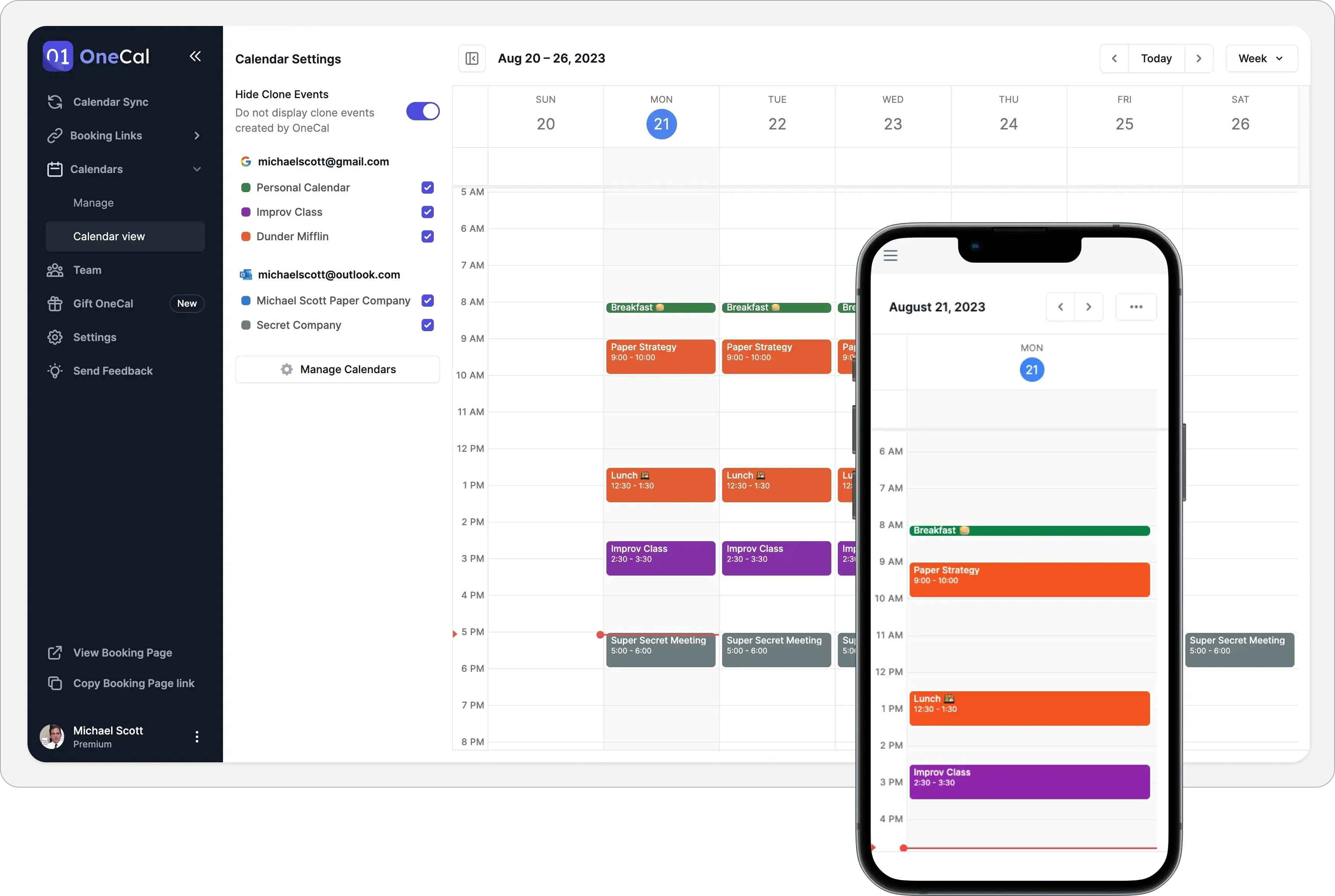
-Cal.com doesn’t have a calendar view feature.
Real-time Calendar Sync:
- One of the greatest features offered by OneCal is its Calendar Sync feature. With Calendar Sync, you can sync multiple Outlook and Google Calendars in less than one minute. This feature is handy for busy professionals who use multiple calendars on a daily basis, and use Google Calendar or Outlook for internal meetings. Without Calendar Sync, you’ll be prone to scheduling conflicts, as co-workers won’t know your availability in your other calendars. If you sync your calendars, your calendars will be up to date with the meetings from other calendars, streamlining your schedule and avoiding double bookings.
- Cal.com doesn’t have a Calendar Sync feature.Scheduling Configuration & Feature: Even though OneCal offers a Booking Links feature, it doesn’t offer as many options as Cal.com. The Booking Links OneCal offers are better suited as multi-purpose booking links. Cal.com supports team booking links, and more advanced configurations compared to OneCal.
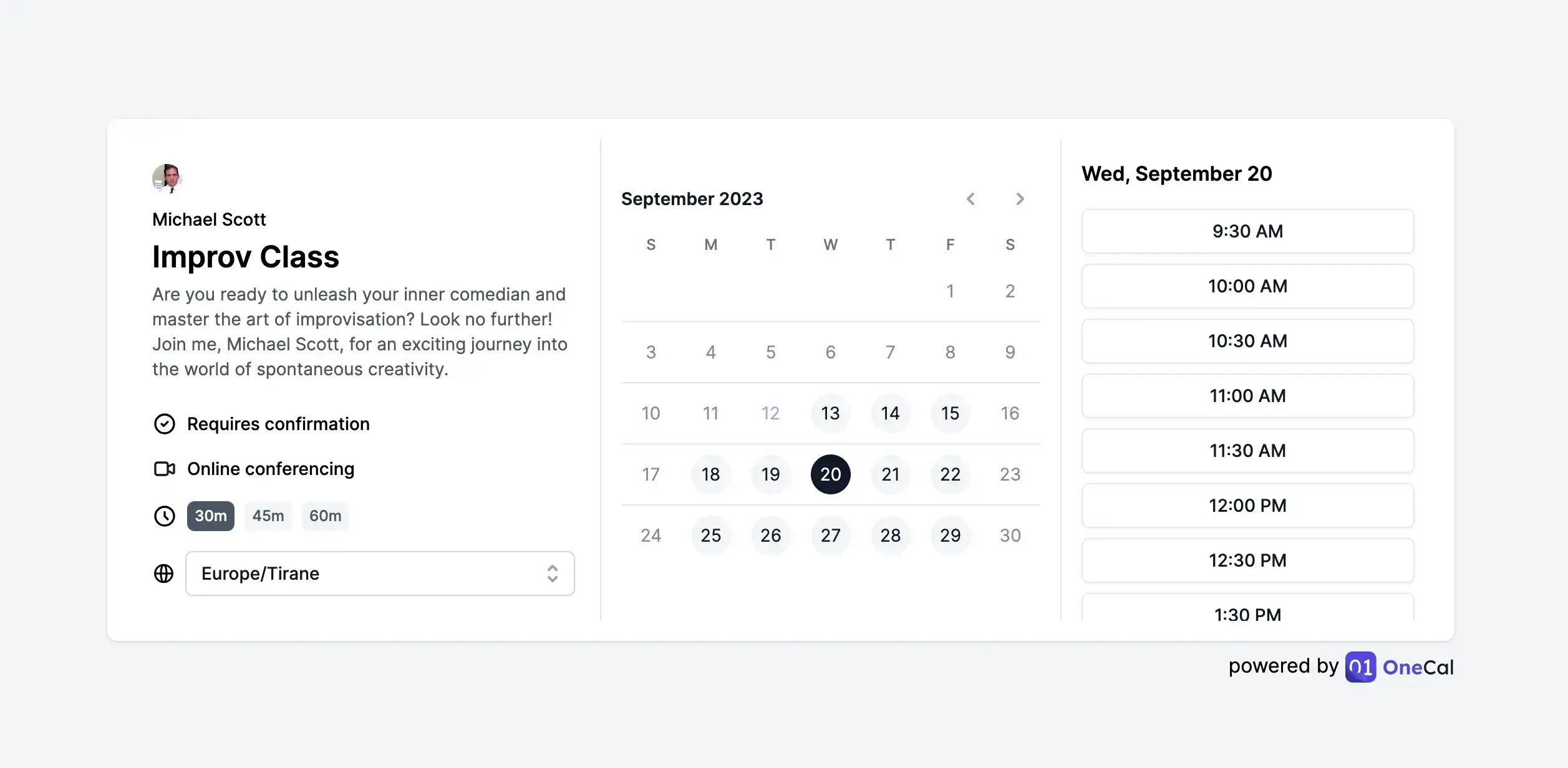
What do OneCal and Cal.com have in common?
Time Zone Management: Both apps offer automatic timezone detection, allowing the user to pick the timezone he wants to schedule meetings. Furthermore, the timezone is automatically adjusted to each participant’s preference.
Top-notch UI: Both Cal.com and OneCal have extremely user-friendly user interface and experience. Scheduling meetings, creating booking links, and handling scheduling requests is a breeze.
Time-saving Appointment Booking: Users can easily share their scheduling links or embed booking forms on their websites, allowing clients and colleagues to book appointments without the need for back-and-forth emails.
Outlook and Google Calendar support: Both OneCal and Cal.com support Outlook and Google Calendar, allowing users to connect all the calendars and create booking links with ease.
Email Notifications: Both apps send automated emails to booking link owners and participants. The notifications range from when a user books a meeting, to when a meeting is accepted or declined.
Mobile accessible: OneCal and Cal.com are highly optimized for mobile and can be used in any mobile device with ease.
Custom availability: Users can set their availability preferences for each booking link. Furthermore, users can mark certain dates as unavailable.
Buffer times, Limit Future Booking, Minimum notice period, and more: OneCal and Cal.com offer the ability to set limits on how often you can be booked and prevent back-to-back meetings.
OneCal pricing
OneCal offers a 14-day free trial, no credit card required. After your trial finishes, you’ll have to purchase one of the paid plans to continue using the service. The plans are:
Starter: $5/user/month
Essential: $10/user/month
Premium: $25/user/month
Custom/Enterprise Plans
You can sign up for a 14-day free trial of OneCal to schedule meetings and sync your calendars in less than one minute. No credit card is required.
2. Calendly

Cal.com started out as a Calendly Open Source Alternative, so it’s fair to say that the goal was to make an alternative to Calendly that was open-source and offered the same features as Calendly.
Calendly is probably the most well-known scheduling platform in the world, used by millions of professionals around the world. As you’d expect, Calendly offers features that accommodate the needs of most busy people, such as Team scheduling links, multi-use booking links, handling payments, and much more.
If you want to learn more about Calendly and its competitors, read our blog post on the little-known Calendly Alternatives.
What differentiates Calendly from Cal.com?
Closed source: Although whether a platform is open source is not a deciding factor for most users, it’s worth mentioning that, unlike Cal.com, Calendly is not Open Source. This means that users can’t see the source code of the applications that are server live.
Limited Free Plan: Unlike Cal.com, Calendly doesn’t offer a generous free plan like Cal.com does. Cal.com is free for individuals, which gives it a strong proposition for most users. In order to fully use Calendly, you’ll have to purchase one of their paid plans.
Top Notch UI: Both platforms offer quite intuitive user interfaces, so you won’t have any issues with any of them. Navigating the menus and features is easy, same for using the booking links created by each platform. Although subjectively, I prefer the UI and UX of Cal.com, I can’t complain about Calendly, as they’ve recently refreshed the UI and UX, which means that they’re also constantly improving, props to that.
What do Calendly and Cal.com have in common?
Lots of integrations: Both platforms are quite powerful when it comes to integrations. Cal.com has the concept of Apps, which allow you to connect tens of different apps, such as Zoom, CalDav, Cron, Discord, and more. Calendly also has more integrations compared to Cal.com as they’re the veterans in digital scheduling. Using Calendly, you can choose between hundreds of integrations, such as Asana, Airtable, Chrome, ClickUp, and more.
Team Scheduling: Both platforms allow you to create team scheduling links, that pull availability from multiple people's calendars, in one booking link.
Ability to receive payments: Both platforms allow you to receive payments when someone books time with you.
Calendly Pricing
Calendly has a free plan that offers unlimited meetings with one event type but is more constraining compared to the free plan offered by Cal.com, which has unlimited event types. Calendly has these plans:
Free
Standard: $10 per seat, per month
Teams: $16 per seat, per month
Enterprise: Contact for pricing
3. Acuity Scheduling

Along with Calendly, Acuity Scheduling is one of the first online booking platforms, focusing more on industry-specific offerings.
What differentiates Acuity Scheduling from Cal.com?
Acuity Scheduling offers generic scheduling links, but the core differentiator from Cal.com is the focus they have on industry-specific features:
Group Classes and Workshops: Acuity allows the scheduling of group sessions such as classes, workshops, or events, including managing class sizes and allowing clients to book their spots online.
Memberships and Subscriptions: Clients can sign up for recurring appointments and subscriptions, providing a steady revenue stream for the business.
Customizable Intake Forms: Before the appointment, businesses can create custom intake forms to collect client information, ensuring that they have all the details they need before the meeting.
Discount Coupons: Businesses can create discount codes and coupons that clients can use when booking, which can help in marketing campaigns and customer loyalty strategies.
Multiple Location Management: For businesses operating in more than one location, Acuity can manage multiple locations and staff schedules from a single account.
API Access for Custom Integration: For businesses with custom needs, Acuity offers API access to build custom integrations with other software and services.
What do Acuity Scheduling and Cal.com have in common?
Given that Acuity Scheduling is one of the first to offer scheduling links, it’s quite mature and feature-rich. Both Acuity Scheduling and Cal.com offer:
Automated Notifications: Acuity Scheduling and Cal.com send automated emails and reminders to participants, to reduce no-shows.
Time Zone Management: Both platforms detect the timezone of the user who is scheduling and adjust to it, in order to avoid meeting conflicts and confusion.
Customizable Booking Pages: Users can customize their booking pages to align with their Brand look and feel.
Group Scheduling: Both platforms allow scheduling for group events, where they get the availability from multiple people, and use a single link to book time.
1:1 scheduling: Cal.com and Acuity Scheduling allow multi-purpose scheduling links.
Payment Processing: Cal.com and Acuity Scheduling allow clients to pay for services upon booking. They integrate with Stripe and PayPal to make this possible.
Multiple Team Members: They allow multiple team members to be added to the account, each with their own schedules and availability.
Acuity Scheduling Pricing
Acuity Scheduling doesn’t have a free plan, which means that you’ll have to purchase one of their plans to get started scheduling:
Emerging: $20 per month
Growing: $34 per month
Powerhouse: $61 per month
Looking for Acuity Scheduling Alternatives? We wrote a comprehensive article on The Best Acuity Scheduling Alternative and Competitors.
4. Savvycal
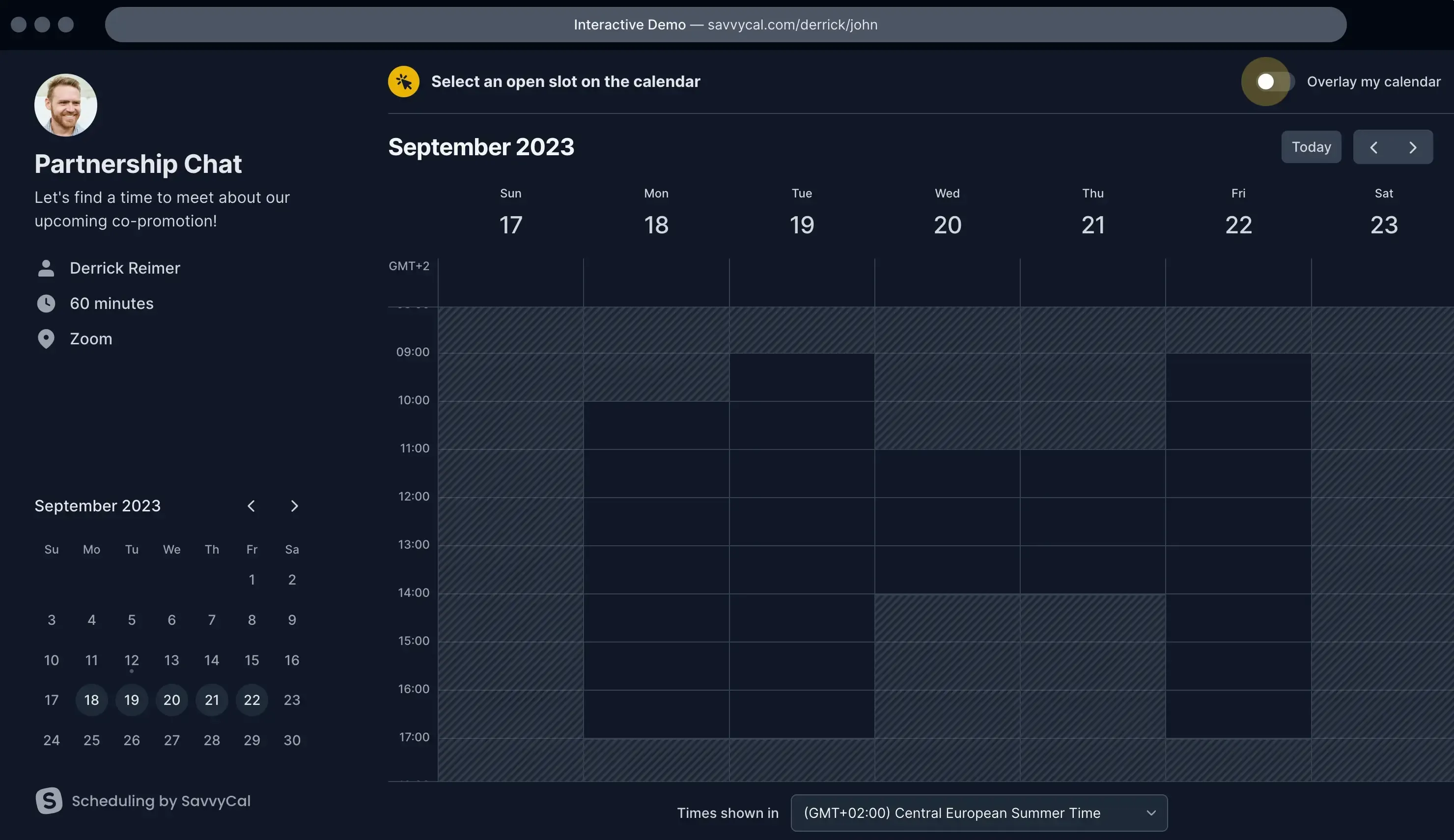
SavvyCal is a scheduling platform that started the trend of scheduling through the Calendar Overlay approach, which Cal.com adapted recently. The way the Calendar Overlay works is that you don’t get the usual ‘pick a date and time, schedule’ UI. You get to connect your calendar, and your schedule overlays with the schedule of the person you’re booking time with. By overlaying both calendars, you’ll spot the free slots of both of you, making the scheduling experience more intuitive.
What differentiates SavvyCal from Cal.com?
Meeting Polls: Allows participants to vote for a meeting time.
Poppy UI: It has to be said that the UI of SavvyCal is more poppy, as it’s quite colorful, so it stands out.
Overlaying Calendars: SavvyCal allows users to overlay their calendar on top of a recipient's calendar to find overlapping available times, simplifying the process of finding a mutual time slot. Note that this feature is now also supported by Cal.com.
Closed Source: Same as the other alternatives, SavvyCal is not open source. Although this is not a deciding factor for most users, it’s worth mentioning
What do SavvyCal and Cal.com have in common?
Multiple Meeting Types: Both SavvyCal and Cal.com enable users to set up different types of meetings, such as 15-minute consultations or hour-long sales calls, and control how these appear to invitees.
Team Scheduling: Both Cal.com and SavvyCal offer team scheduling links that allow booking time in a group. The details might be different, but the concept is the same.
One-on-One Meetings: They are both capable of handling one-on-one appointment bookings.
Availability Control: Users can set their availability preferences, including which days and times they are available for meetings.
Automated Email Notifications: SavvyCal and Cal.com send automated emails for booking confirmations, reminders, and cancellations to keep participants informed.
Buffer Times: SavvyCal and Cal.com offer the ability to set buffer times between meetings, allowing users to manage their availability and prevent back-to-back bookings.
Time Zone Support: Both services automatically handle time zone conversions, ensuring that meeting times are correct for participants in different geographical locations.
User Interface and User Experience: While the look and feel may be different, both platforms aim to provide a user-friendly interface and a smooth scheduling experience for both the organizer and the attendee.
SavvyCal Pricing
SavvyCal offers a free plan, but it’s extremely limited, as you can only use it to explore the features they offer, not to actually share a booking link. In order to use their features, you have to upgrade to one of the following plans:
Free: Very limited, you can only use their overlay feature but not for scheduling.
$12 per user, per month: Create your own individual and team scheduling links (in addition to free meeting polls).
$20 per user, per month: Remove SavvyCal branding from your links, collect payments via Stripe, and delegate access to your assistant.
Our article on the top SavvyCal alternatives highlights what makes SavvyCal unique, as well as what the competition brings to the table.
5. Doodle

Doodle has been in the scheduling links business since it launched in 2007, and has acquired millions of users since.
What differentiates Doodle from Cal.com?
Doodle Polling: The Polling feature allows a meeting organizer to propose multiple time options and invite participants to vote on their preferred times, making it quite useful for finding the best time for group meetings.
Booking Page Customization: While customization is available, it may not be as extensive as Cal.com.
Ads in the free version: Compared to Cal.com, Doodle has ads in the free version. This is a deal breaker for many users, considering the fact that Cal.com has a very generous fee plan, allowing you to use all features for free if you’re using it as an individual.
UI and UX: Doodle has evolved over time, but it has to be said that Cal.com is more modern in terms of UI and feels easier to use compared to Doodle.
Developer-Friendly: Doodle doesn’t offer APIs to access the platform, compared to Cal.com offers APIs for developers to build on top of it.
What do Doodle and Cal.com have in common?
Time Zone Detection: Doodle and Cal.com automatically handle time zone conversions to help schedule meetings across different geographical locations without confusion
Availability Settings: Doodle and Cal.com allow users can define their availability for meetings, allowing them to control when they can be booked and to avoid overbooking or scheduling conflicts.
Different Meeting Types: Both services allow users to create different types of meetings or events, which can be used for different purposes.
Group Scheduling: Doodle and Cal.com offer group scheduling links.
Customizable Booking Pages: Users can personalize their scheduling page to some extent on both platforms, even though Cal.com takes the edge on this one.
Automated Notifications: Doodle and Cal.com send out automated email notifications for bookings, cancellations, and reminders, helping keep all participants informed.
Doodle Pricing
Although you can use the free version of Doodle, it’s inferior compared to the free plan offered by Cal.com. Furthermore, the free version of Doodle has ads. Doodle plans are:
Free
Pro: $14.95 per user per month
Team: $19.95 per user per month
Enterprise: Contact for pricing
Note: You can save 50% if you purchase an annual plan.
If Doodle sounds interesting, read our article on the best Doodle alternatives for scheduling and polling.
6. Clara
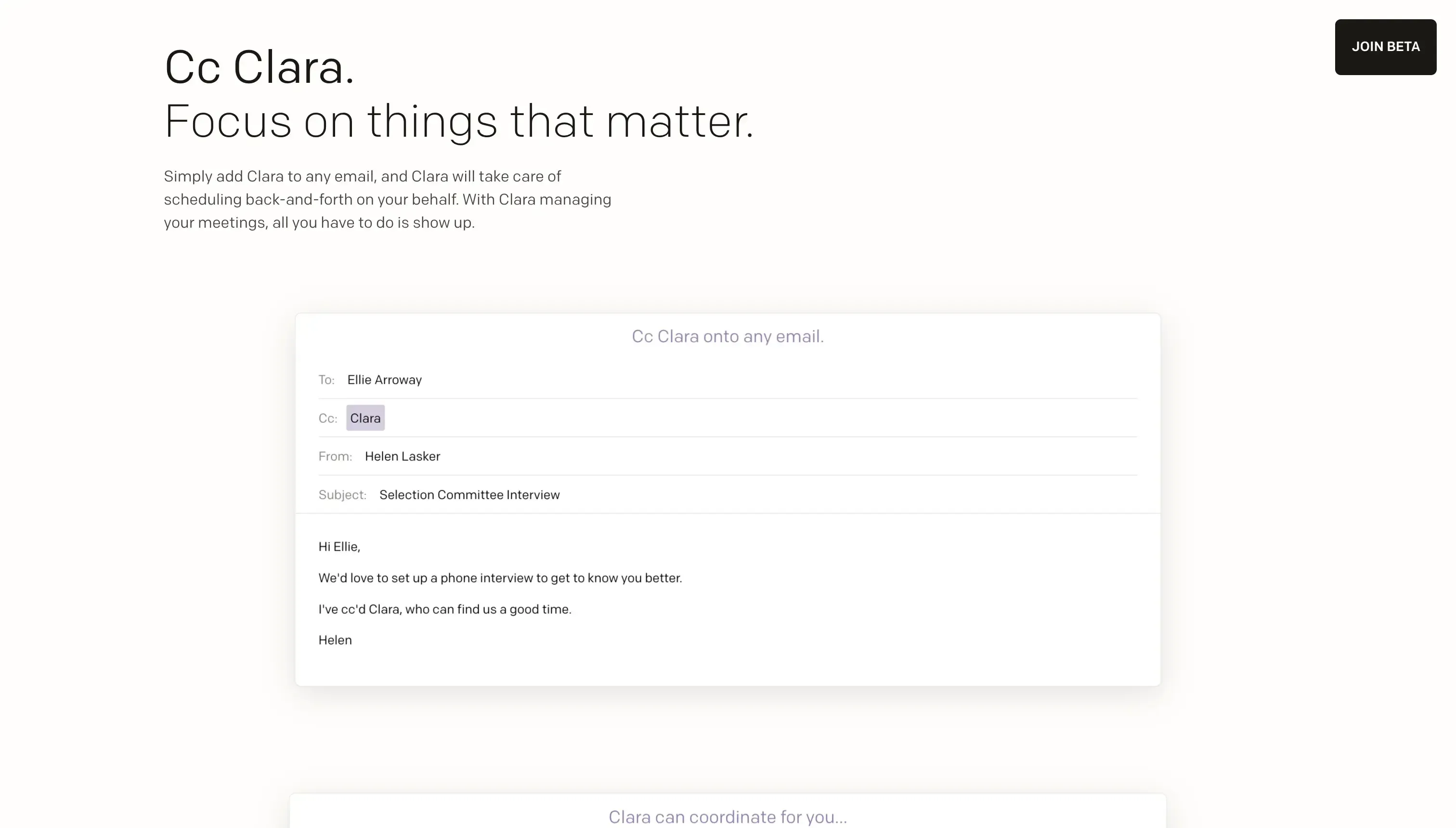
Given that Cal.com has launched Cal.ai, let’s throw one platform that’s similar to what Cal.com launched recently: Clara. With Clara, you can write in human language, and Clara schedules meetings with you.
Let’s assume you want to schedule a meeting with Alice, open your inbox, compose a new email, and add Clara’s email as a CC.
You could write something like: "Hey Alice, I’d love to schedule a meeting with you to know you better. Regards, Eraldo"
A couple of minutes later, Clara will take a look at your schedule, and reply:
Hi Eraldo,
Happy to get something on the calendar for you and Alice.
How does 2 p.m. PDT on Monday, October 2nd work for you? Also, what's the best number to reach you at?
Best, Clara
The best part of using Clara is that it’s quite capable of handling back and forth, rescheduling, or canceling meetings. As long as you keep Clara in the email’s CC, everything works as expected.
Note that Cal.com has integrated Cal.ai into Cal.com, so you have one platform to manage your traditional scheduling links, and conversational meetings.
Clara Pricing
The previous public price was $99 per month, but it’s since removed. You can only join their beta now.
Looking to leverage AI Calendar Tools to enhance your productivity? Check our article on the Best AI Calendar Tools and Apps.
7. Google Appointment Scheduler
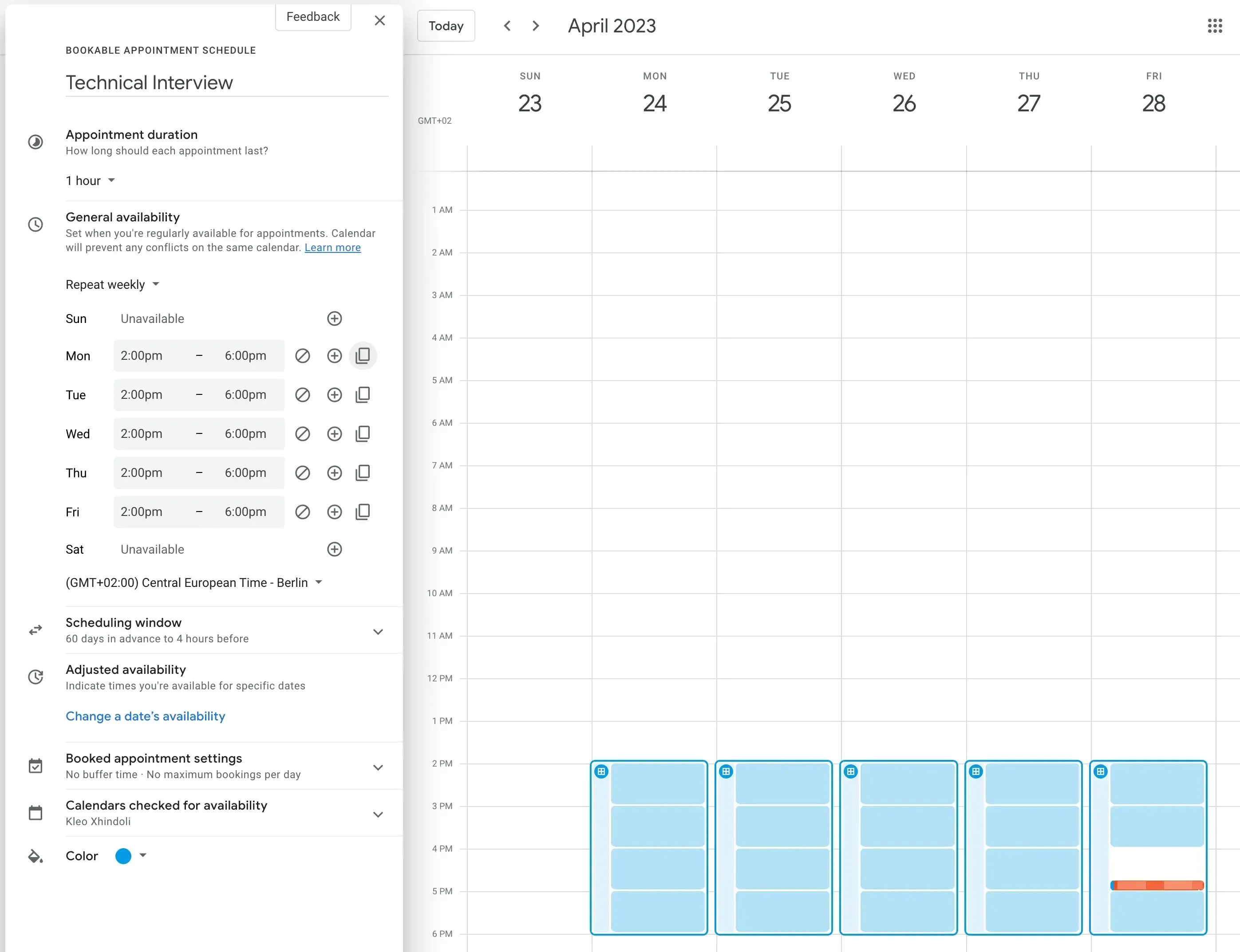
In 2023, Google launched its own scheduling links feature, called Google Appointment Scheduler, which allows you to create scheduling links straight from Google Calendar.
What differentiates Google Appointment Scheduler from Cal.com?
Integration with Google Services: Google Appointment Scheduler is tightly integrated with Google Calendar and other Google Workspace services, providing a seamless experience for users already embedded in the Google ecosystem.
Google Workspace Compatibility: If you already use Google Workspace, it’s quite convenient to use Google Workspace, as you won’t need to set up an account or extra details.
Basic Customization: While there is some ability to customize appointment details, it's relatively basic compared to the customization options offered by Cal.com.
Free for Google Workspace Users: It is available at no extra cost for individuals and organizations with Google Workspace accounts.
Only Google Calendar Support: Given that Google Appointment Schedule integrates with Google Calendar, it’s not a bummer that you can’t connect to Outlook directly, as you can do in Cal.com. To solve that, you’ll have to bring Outlook events into Google Calendar. To do so, you can read our article on how to connect multiple calendars on Google Appointment Scheduler.
What do Google Appointment Scheduler and Cal.com have in common?
Time Zone adjustment: Both services automatically adjust for time zones, making sure that everyone is aligned on the correct meeting time.
Availability Customization: Users can specify available times for meetings, allowing them to manage their schedules and prevent overbooking.
Event Types: Google Appointment Scheduler and Cal.com both allow users to create different event types with unique durations and potentially distinct availability settings.
Automated Notifications: Both platforms send automated confirmations and reminders to inform participants about any change happening to the meetings.
Clean User Interface: Both platforms provide user interfaces that are designed to be intuitive for scheduling without extensive training or setup. The Cal.com interface is more modern, but you can’t blame Google for sticking to its design language and keeping the Appointment Scheduler in line with Google Calendar and other Google products.
Multiple Time Slot Selection: Users can offer multiple time slots for each type of appointment, giving invitees the flexibility to choose a time that works best for them.
Personal and Team Scheduling: Both platforms have the capability to manage personal appointments as well as support team scheduling scenarios.
Google Appointment Scheduler Pricing
Compared to Cal.com, Google Appointment Scheduler doesn’t have a free plan. In order to use it, you’ll have to subscribe to Google Workspace Individual, which costs $10 per month.
If you want to try Google Appointment Scheduler, we wrote an article on How to use Google Appointment Scheduler. In this article, we explain in great each feature of Google Appointment Scheduler and how to get started with it.
Which Cal.com Alternative is Best For Your Scheduling Needs?
We did our best to highlight the differences and common features of each alternative to Cal.com, so ultimately the decision is up to you. To sum up:
If you want a mix of Booking Links and the ability to sync your calendars, OneCal is a solid Cal.com alternative.
If you want industry-specific features, Acuity Scheduling is the platform to try out.
If you need a specific integration, chances are that Calendly has it.
If you want an AI assistant to schedule meetings for you through email, Clara is the way to go.
Get Booked using OneCal
Sign up for a 14-day free trial to get booked in less than one minute. Furthermore, if you schedule internal meetings through Outlook or Google Calendar, you can sync all your calendars so your team knows your real availability and never double-books you.